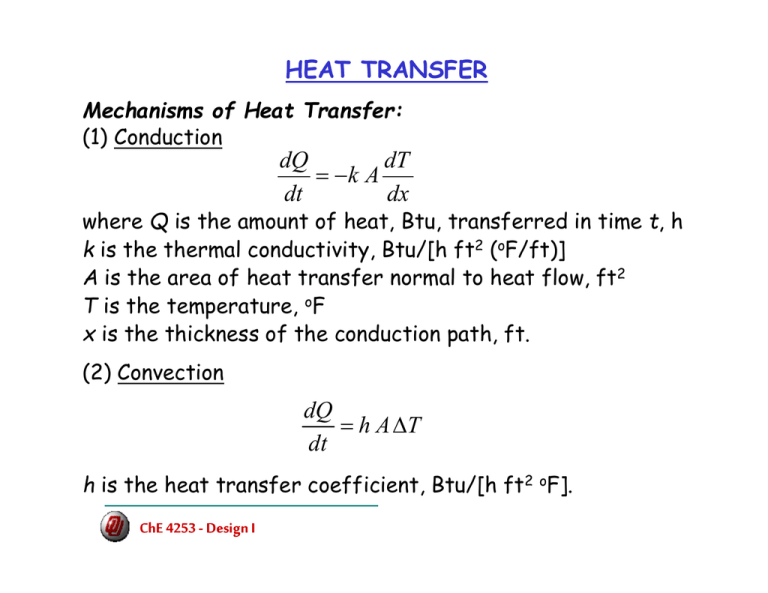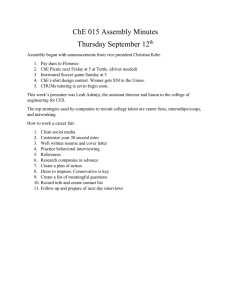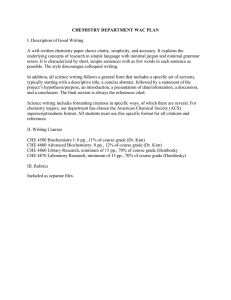HEAT TRANSFER dx dT Ak dt dQ − = TAh dt dQ Δ =
advertisement

HEAT TRANSFER Mechanisms of Heat Transfer: (1) Conduction dQ dT = −k A dt dx where Q is the amount of heat, Btu, transferred in time t, h k is the thermal conductivity, Btu/[h ft2 (oF/ft)] A is the area of heat transfer normal to heat flow, ft2 T is the temperature, oF x is the thickness of the conduction path, ft. (2) Convection dQ = h A ΔT dt h is the heat transfer coefficient, Btu/[h ft2 oF]. ChE 4253 - Design I HEAT TRANSFER Mechanisms of Heat Transfer: (3) Radiation dQ = σ ε AT 4 dt where σ is the Stefan-Boltzmann constant = 0.1713 10-8 Btu/(h ft2 oR4) ε is the emissivity of surface A is the exposed area for heat transfer, ft2 T is absolute temperature, oR. ChE 4253 - Design I Overall Heat Transfer Coefficient Definition of the overall heat transfer coefficient, U q = U A ΔTtot U [=] Btu/(h ft2 oF) ΔTtot is the total temperature difference (overall driving force for the process). Important: The overall heat transfer coefficient, U, is an approximate value. It is defined in combination with the area A (e.g. inside/outside area of a pipe). ChE 4253 - Design I Overall Heat Transfer Coefficient Heat flux rin rout General correlation: Intensity=Potential/Resistance Rate = Driving Force/Resistance Applies for electricity, flow, flux etc. Heat transport: q = U A ΔTtot Overall resistance, R=1/UA ChE 4253 - Design I Overall Heat Transfer Coefficient Resistances in series: Overall resistance = Sum of resistances In our case: Heat flux rin rout 1 1 1 d o ln (d o d i ) d o 1 d o 1 = + + + + U o ho hod 2k w d i hi d i hid Uo: overall heat transfer coefficient based on the outside area ho, hi: outside/inside film heat transfer coefficient do, di: outside/inside pipe diameter kw: wall thermal conductivity hod, hid: outside/inside fouling heat transfer coefficient ChE 4253 - Design I Heat Transfer Equipment Usual terminology: • Exchanger: heat exchange between two process streams. • Heater or Cooler: a process stream is heated/cooled by a utility stream. • Vaporiser: a process stream is completely vaporised. • Reboiler: vaporiser associated with a distillation column. • Evaporator: used to concentrate a solution. • Fired heater: heating is done by combustion. ChE 4253 - Design I Heat Transfer Equipment • Double-pipe exchanger, used for cooling or heating. • Shell and tube heat exchangers • Plate-fin exchangers. • Spiral heat exchangers. • Air cooled: coolers and condensers. • Fired heaters. ChE 4253 - Design I Heat Transfer Equipment Tube and shell heat exchanger: ChE 4253 - Design I Heat Transfer Equipment Tube and shell heat exchanger: ChE 4253 - Design I Heat Transfer Equipment Tube and shell heat exchanger: ChE 4253 - Design I Heat Transfer Equipment Tube and shell heat exchanger: ChE 4253 - Design I Heat Transfer Equipment Tube and shell heat exchanger: Baffles ChE 4253 - Design I Heat Transfer Equipment Tube and shell heat exchanger: Tube Pitch ChE 4253 - Design I Heat Transfer Equipment Trains ChE 4253 - Design I Heat Transfer Equipment TEMA Tubular Exchanger Manufacturers Association ChE 4253 - Design I Heat Transfer Equipment Spiral Exchangers ChE 4253 - Design I Heat Transfer Equipment Plate Exchangers ChE 4253 - Design I Heat Transfer Equipment Spiral Wound Exchangers ChE 4253 - Design I Heat Transfer Equipment Air Coolers ChE 4253 - Design I Heat Transfer Equipment LNG Exchangers Plate ChE 4253 - Design I “Special Shell and Tube” Heat Exchangers - Typical Old Fashion design 1) Define duty: heat transfer rate, flows, temperatures. 2) Collect required physical properties (ρ, μ, k). 3) Decide on the type of exchanger. 4) Select a trial value for U. 5) Calculate the mean temperature difference, ΔTm 6) Calculate area required. 7) Decide on the exchanger layout. 8) Calculate individual coefficients. 9) Calculate U. If significant difference from step (4), substitute in (4) and repeat. 10) Calculate the pressure drop. If it is not satisfactory, back to (7) or (4) or (3). 11) Optimise: repeat (4) to (10) to determine cheapest solution (usually smaller area). ChE 4253 - Design I Heat Exchangers (4) Use first order approximations for U, such as table 14-5 pg. 663 in PT&W. T1 T2 t2 Now we have: t1 q = U A ΔTtot at every location in the exchanger. In differential form: dq = (U )loc (ΔTtot )loc dA and in a simplified integral/overall form (used in step 6) : q = U A ΔTm ChE 4253 - Design I Overall Heat Transfer Coefficient ChE 4253 - Design I Heat Exchangers T1 T2 t2 t1 (5) Mean temperature difference for counter-current flow: ( T1 − t 2 ) − (T2 − t1 ) ΔTm = ΔTlm = ( T1 − t 2 ) ln (T2 − t1 ) In reality, combination of co-current, countercurrent and cross flow. What do we do? Use a correction factor, Ft, (see figs 14-4 and 14-5 in PT&W) ΔTm = Ft ΔTlm Parameters: ( T1 − T2 ) R= , (t2 − t1 ) ChE 4253 - Design I ( t 2 − t1 ) S= (T1 − t1 ) Heat Transfer Equipment Correction factor: Heat Transfer Equipment Correction factor: Heat Transfer Equipment Correction factor: Heat Transfer Equipment Correction factor: Heat Exchangers - Typical design 1) Define duty: heat transfer rate, flows, temperatures. 2) Collect required physical properties (ρ, μ, k). 3) Decide on the type of exchanger. 4) Select a trial value for U. 5) Calculate the mean temperature difference, ΔTm 6) Calculate area required. 7) Decide on the exchanger layout. 8) Calculate individual coefficients. 9) Calculate U. If significant difference from step (4), substitute in (4) and repeat. 10) Calculate the pressure drop. If it is not satisfactory, back to (7) or (4) or (3). 11) Optimise: repeat (4) to (10) to determine cheapest solution (usually smaller area). ChE 4253 - Design I Shell and Tube Heat Exchangers Most commonly used heat exchangers. Advantages: • Large surface area in a small volume. • Good mechanical layout. • Uses well established fabrication methods. • Can be constructed from a wide variety of materials. • Easily cleaned and maintained. • Well established design procedures. ChE 4253 - Design I Shell and Tube Heat Exchangers Tube size: Length is standard, commonly 8, 12 or 16 ft. Diameter: most common 3/4 or 1 in OD Tube pitch and clearance: Pitch is the shortest center-to-center distance between adjacent tubes. Commonly 1.25 to 1.5 time the tube diameter. Clearance is the distance between tubes. It should be larger than 25% of the tube diameter. Triangular or square arrangement of tubes are quite common. Baffles: Baffles are usually spaced between 20% and 100% of the ID of the shell. ChE 4253 - Design I Shell and Tube Heat Exchangers Fluid location: Corrosive fluids flow inside the tubes. Fluid with higher fouling tendency inside the tubes. High pressure fluid inside the tubes (if everything else the same). Hot fluid inside the tubes. Typical velocities: Liquids: 1-2 m/s in tubes, max 4 m/s to reduce fouling. 0.3 to 1 m/s in shell Vapors: 50-70 m/s (vacuum), 10-30 m/s (1 bar), 5-10 m/s (high P) ChE 4253 - Design I Shell and Tube Heat Exchangers Shell: Up to 24 in nominal size, use standard pipes. Passes: Most usual pass is one (type E according to TEMA standards). Split flow arrangement (types G and J) are used for pressure drop reduction, when the pressure drop is the controlling factor in the design. ChE 4253 - Design I Heat Exchangers: The T-Q Diagram • A T-Q diagram is a visual representation of the energy balance equation for each stream. 400oC 200oC 175oC 100oC Single phase streams with constant Cp and no pressure effect on enthalpy: q = m& C p ΔT Pure components undergoing phase change: q = m& λ ChE 4253 - Design I Heat Exchangers: The T-Q Diagram For the previous example: 400oC T 175oC Slope=1/m2Cp2 Driving Force 200oC 100oC Slope=1/m1Cp1 Q The T-Q diagram reveals two important truths regarding heat transfer: (1) T-lines for counter-current flows do not cross! It is impossible. (2) T-lines should not approach each other too closely: As they approach, the area required for heat transfer goes to infinity. The point of closest approach is called pinch point. ChE 4253 - Design I Heat Exchangers: The T-Q Diagram Examples: (a) (b) Condensing 250oC 250oC 200oC 250oC 220oC T 100oC Q zone subcooling zone 225oC T 120oC Q (a) A single-phase stream is heated from 100 to 200oC by condensing saturated steam to saturated liquid at 250oC in a countercurrent heat exchanger. (b) A single-phase stream is heated from 120 to 220oC by condensation of saturated steam at 250oC and by subcooling the liquid to 225oC in a countercurrent heat exchanger. ChE 4253 - Design I Shell and Tube Heat Exchangers - Design • Tube side: Configuration (pitch, number of tubes, dimensions). Heat transfer coefficient. Pressure drop. • Shell side: Configuration (dimensions, baffles). Heat transfer coefficient. Pressure drop. Cost influenced by: • Heat transfer area • Tube diameter and length • Pressure • Material of construction • Baffle type • Special features, such as U bends, floating heads, fins etc. ChE 4253 - Design I Tube Side 1) Define duty: heat transfer rate, flows, temperatures. 2) Collect required physical properties (ρ, μ, k). 3) Select a value for U. 4) Calculate the mean temperature difference, ΔTm. Use the correction factor, Ft . 6) Calculate area required. 7) Decide on the exchanger layout. Select one of the standard tube lengths and tube diameters. Calculate the number of tubes needed from the area estimated in (6). Decide on pitch. Calculate bundle diameter from the following: ⎛ Db ⎞ N t = K1 ⎜⎜ ⎟⎟ ⎝ do ⎠ ChE 4253 - Design I n1 ⎛ Nt ⎞ Db = d o ⎜⎜ ⎟⎟ ⎝ K1 ⎠ 1 n1 Tube Side 1 Nt is the number of tubes ⎛ N t ⎞ n1 Db = d o ⎜⎜ ⎟⎟ Db is the bundle diameter ⎝ K1 ⎠ do is the tube outside diameter Constants: Triangular pitch, pt =1.25do No. passes 1 0.319 K1 n1 2.142 Square pitch, pt =1.25do No. passes 1 K1 0.215 2.207 n1 ChE 4253 - Design I 2 4 6 8 0.249 0.175 0.0743 0.0365 2.207 2.285 2.499 2.675 2 4 6 8 0.156 0.158 0.0402 0.0331 2.291 2.263 2.617 2.643 Heat Transfer Equipment Tube Side From the bundle diameter calculate shell diameter! 8) Calculate heat transfer coefficient. For turbulent flow inside the tubes (Sieder & Tate): Nu = C Re Pr 0.8 0.33 ⎛ μ ⎞ ⎜⎜ ⎟⎟ ⎝ μw ⎠ 0.14 Nu is the Nusselt number, Nu = hi de / kf Re is the Reynolds number, Re= ρ ut de /m Pr is the Prandtl number, Pr = Cp μ / kf ut is the fluid velocity inside the tube, kf is the fluid conductivity de is the equivalent (hydraulic) diameter de = 4 x (cross section area available to flow)/(heated perimeter) C= 0.021 for gases, 0.023 for non-viscous and 0.027 for viscous liquids ChE 4253 - Design I Tube Side Use of the heat transfer factor, jh, for transition and laminar flow: 0.14 0.33 ⎛ μ ⎞ Nu = jh Re Pr ⎜⎜ ⎟⎟ ⎝ μw ⎠ See figure 14-9 in page 658 of PT&W. Also, see table 14-3, pg. 661 in PT&W. 9) Calculate pressure drop. Use the friction factor, as for pipe flows, in the Fanning equation. ChE 4253 - Design I Heat Transfer Factor ChE 4253 - Design I Tube Side 9) Calculate pressure drop. ΔPi = Bi 2 f i G 2 Ln p g c ρ i d iφi fi is the friction factor for isothermal flow at the mean temperature np is the number of tube passes gc is the unit conversion factor φi is a correction factor for non-isothermal flow φi = 1.1(μ i μ w )0.25 φi = 1.02(μ i μ w )0.14 for Re < 2100 for Re > 2100 Bi is a correction factor for friction due to contraction, expansion and reversal of flow direction G is the mass velocity inside the tube ChE 4253 - Design I Shell Side From the bundle diameter we have the shell diameter (step 7)! 10) Calculate shell side heat transfer coefficient. For turbulent flow outside the tubes: ao Nu = Re 0.6 Pr 0.33 Fs Nu is the Nusselt number, Nu = ho do / kf Re is the shell side Reynolds number, Re= Gs do /μ Pr is the shell side Prandtl number, Pr = Cp μ / kf ao = 0.33 if the tubes are staggered and 0.26 if they are in line Fs is a safety factor to account for bypassing (usually 1.6) Gs is the mass velocity across tubes, based on the minimum free area between baffles. Also see: Kern, “Process heat transfer”, McGraw Hill, 1950 Shell Side 11) Calculate pressure drop. 2 Bo 2 f oGs N r ΔPo = gc ρo fo is the friction factor for the shell side (see p. 665 PT&W) ⎛ d o Gs ⎞ ⎟⎟ f o = bo ⎜⎜ ⎝ μ ⎠ −0.15 Nr is the number of rows of tubes Bo is a correction factor for friction due to reversal of flow direction. It can be equal to the number of tube crossings (e.g., one when there are no baffles). See example 14-3 in PT&W (pg. 666) 12) Now we can recalculate U and make a decision. ChE 4253 - Design I Heat Transfer Equipment Tube and shell heat exchanger: Modern Simulation (COMSOL, FLUENT) using finite elements ChE 4253 - Design I Heat Transfer Equipment Tube and shell heat exchanger: Commercially the designs are done by companies - HTRI (Heat Transfer Research Institute; http://www.htri.net/index.php) and other programs. - Manufacturers ChE 4253 - Design I

